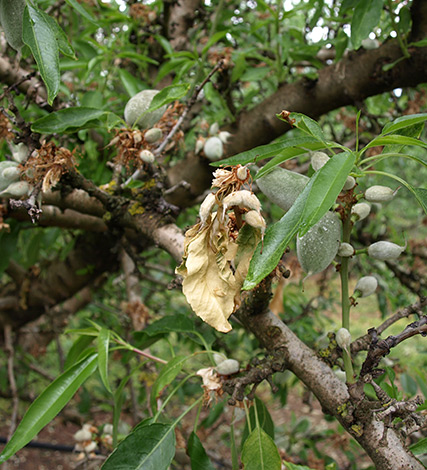Anthracnose
Refer to the links below for more detailed information on anthracnose in other crops.

Description
In avocadoes, anthracnose presents as a fruit rot that remains latent until the fruit ripens and is often only discovered when being prepared by the consumer.
In cucurbits, the symptoms vary between hosts. On the leaves of cucumbers and melons, small brown spots with halos appear which can later develop into round, reddish spots before the centres fall out, resulting in a ‘shot hole’ appearance. On watermelon leaves, the spots are angular, irregular and turn dark brown or black. Spots also appear on the stems and fruit.
In mangos, young leaves are the most susceptible to infection. Small, black and irregular spots form before expanding to larger areas that eventually dry and fall out. The disease can also cause blight of flowers and young shoots and in mature fruit, upon ripening dark brown to black spots form with orange-pink spore masses.
In lettuces, symptoms appear as tiny black spots on the leaves before turning yellow and then brown with a reddish margin as they grow (up to 4 mm). Like cucurbits and mangos, the centres of the lesions can also fall out.
Anthracnose can be seed-borne (although not in lettuce) and carryover via crop residue on the soil before the spores are spread to infect new plants via wind and rain splash.
Control
Management of anthracnose across a range of crops requires an integrated approach using cultural methods and registered fungicides. In some crops, it can be difficult to obtain good control with fungicides as it is hard to get fungicide coverage where it is required. i.e. leaf bases of lettuces. Registered fungicides are also generally best applied before an infection event (i.e. rain) rather than afterwards.Cultural practices to manage anthracnose include;
- Minimising periods of leaf wetness
- Rotating crops to allow spores on the soil or crop residues to lose viability
- Remove or bury contaminated trash residue
- Allow a buffer zone in horticultural crops to minimise disease spread from wind or water splash
- Control alternative hosts
- Plant more tolerant varieties
- Prune trees to aid airflow and reduce humidity
- Inspect regularly to identify disease symptoms early.
Serenade® Opti is registered for the control of anthracnose in avocados, mangos and other tropical fruit, excluding bananas, and should be applied preventatively before disease symptoms are visible. Antracol® is registered for the control of anthracnose in watermelons and rockmelons (Qld, WA only) and Blue Shield® is registered for the control of anthracnose in avocados, lettuces, mangos and macadamias. Check the label for additional information, including State restrictions.
References
Applied Horticultural Research (Viewed December 2019), ‘Fact Sheet: Management of Lettuce Anthracnose’, (http://ahr.com.au/wp-content/uploads/2015/03/Management-of-lettuce-anthracnose.pdfDepartment of Agriculture and Fisheries (2018), ‘Anthracnose’, Queensland Government,
https://www.daf.qld.gov.au/business-priorities/agriculture/plants/fruit-vegetable/diseases-disorders/anthracnose
Department of Agriculture and Fisheries (2018), ‘Pests and diseases of avocado crops’, Queensland Government, https://www.daf.qld.gov.au/business-priorities/agriculture/plants/fruit-vegetable/fruit-vegetable-crops/avocado/pests-and-diseases-of-avocado-crops
Jackson, G (2017), ‘Cucurbit anthracnose (200), Pacific Pests and Pathogens – Fact Sheets, PestNet, http://www.pestnet.org/fact_sheets/cucurbit_anthracnose_200.pdf
Minchinton, E (1999), ‘Anthracnose of beans’, Agriculture Victoria, http://agriculture.vic.gov.au/agriculture/pests-diseases-and-weeds/plant-diseases/vegetable/anthractnose-of-beans
Tsatsia, H and Jackson, G and (2017), ‘Masngo Anthracnose (009), Pacific Pests and Pathogens – Fact Sheets, PestNet, http://www.pestnet.org/fact_sheets/mango_anthracnose_009.htm








